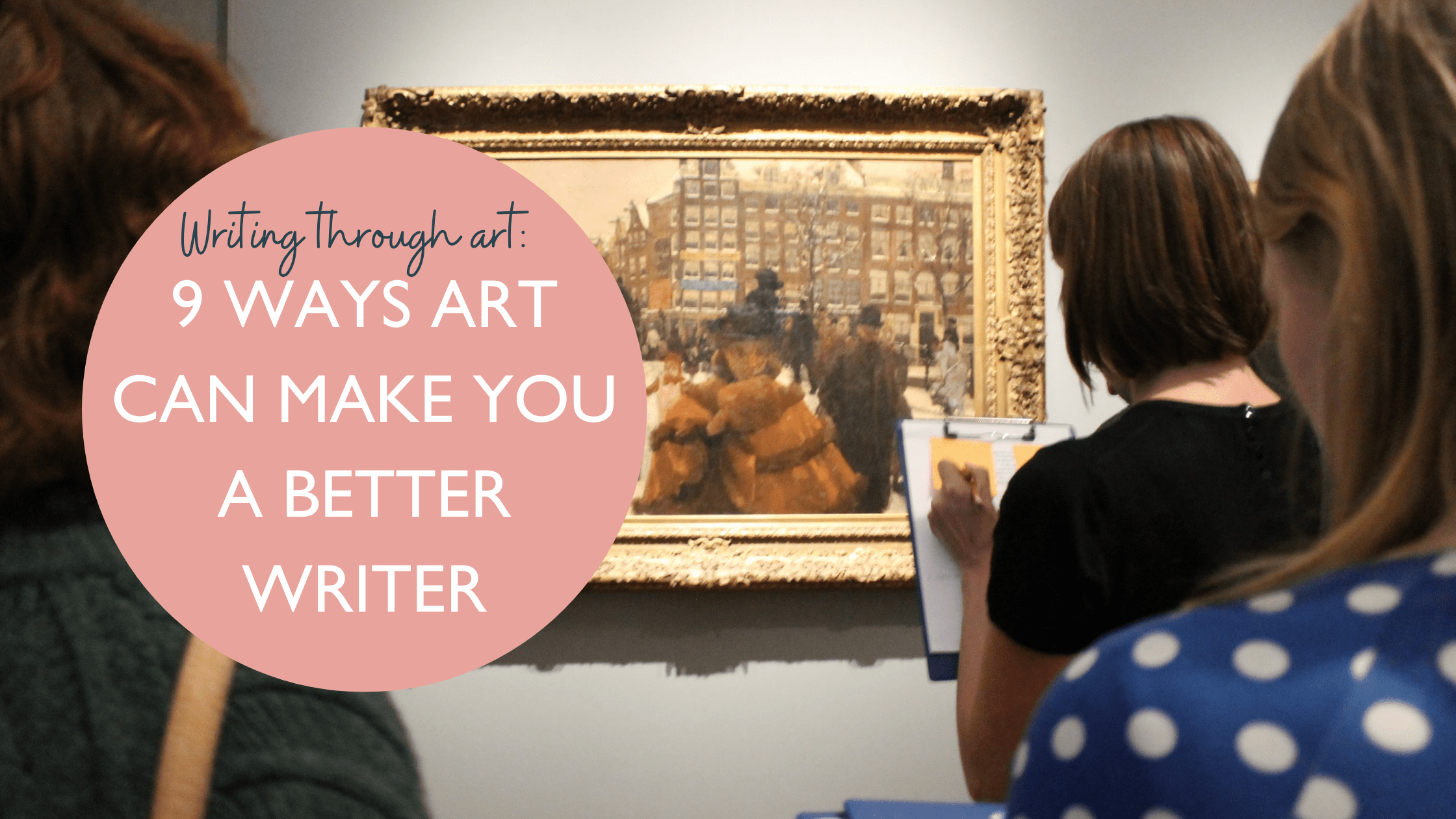Throughout the ages, looking at art has been a unique way of finding inspiration and creativity. If you go as far back as the Greeks, you can find examples of writing inspired by art, called ekphrasis, which means “a literary description of or commentary on a visual work of art”
Art is a frequent source of inspiration for many writers and poets over the centuries. John Keats’ “Ode on a Grecian Urn” is a famous example and William Blake said that poetry and art are ‘ways to converse with paradise’.
But how does this work for us, mere mortals with a keen interest in improving our creative or reflective writing? In this week’s blog I’m exploring 9 ways looking at and discussing art can make you a better writer.
#1 Slow Down
Art invites us to slow down and look closely at what we see. Art and creative works are made to engage and hold our attention. Developing the practice of slow looking will help you to notice more – how you can be more attentive to your environment, see beyond your first impressions and look a little deeper. Looking slowly and carefully naturally asks us to reflect, wonder and ponder – and this reflection leads to new insights and ideas. These new perspectives offer us rich and deep material for writing too.
#2 Train your eye
Looking at and discussing art improves your visual acumen and makes you more alert, aware and attentive to details in all aspects of your personal and work life. If you practice looking at art regularly, your observation skills will noticeably improve. Your ability to describe and use descriptive language will also get better, as you notice more details and find more precise ways to describe what you see.
#3 Make interpretations
Once we have fully observed the artwork, we can then begin to make interpretations or inferences about what is happening. This interpretation draws on the observations and invites us to think about what we’ve already seen and observed. We often ask ‘What do you think is going on’ or ‘What is the story here?’. This part is about thinking creatively and coming up with plausible ideas and hypotheses about the artwork.The observation and interpretation parts leave participants buzzing with ideas and thoughts and this provides a perfect springboard for writing prompts or exercises.
#4 Develop vocabulary and descriptive language
When we describe an artwork we are often using descriptive language to try and evoke an image of the artwork in someone’s mind. Descriptive writing makes use of precise language – the right noun, adjective or verb that will give life to the image you are describing in someone’s mind. I will often ask participants to look for categories of words when observing and describing artworks too – nouns, adjectives, verbs or to be as specific and descriptive as possible when describing colours, shapes and lines – as if they are describing them to someone who is on the telephone. Participants can also make long, descriptive inventories of the artwork in the observation stage. Descriptive language also makes use of the senses (see below) and figurative language – Colour, Symbol, Image and Creative Comparisons are good thinking routines to use with artworks to encourage metaphorical thinking.
#5 Learn how to engage with different perspectives
Once participants have observed and analysed the artwork in question, they can then choose the artist, or a person, object or animal in the image to ‘step inside’ They can then engage in discussion or writing from the perspective of that character – literally stepping inside their shoes and seeing things through their eyes. Through this process, participants can consider different experiences and viewpoints that they discover through ‘stepping inside’ a character.
#6 Inspiration
Taking yourself off to a museum, or going online to take part in an art discussion will allow you to get out of a rut and get inspired. Immerse yourself in some artworks. Think about what might be happening. Let your eyes and your mind wander freely. Choose artworks that you are curious about or ones that draw you in. Looking at art slowly and carefully – either on your own or as part of a group discussion- can dissolve writer’s block and will foster creativity!
#7 Improve our sensory perception
Looking at art stimulates the senses in many ways and can help us to work on our descriptive language skills. Stepping inside an image and being able to describe what you saw, heard, smelt, felt and tasted is a good way to brainstorm ideas for sensorial description. Or write down 50 words for each artwork you look at, with 10 in each sensory category. Being able to describe how something tastes, smells, sounds, or feels rather than the way it looks, will bring your writing to life.
#8 Precision
Looking and discussing art often involves the skills of a detective to investigate, find out and discover answers to questions. Every artwork is full of mystery, intrigue and adventure – the artists and their subjects. Using art as a prompt for writing exercises is a good way to keep asking questions, questions that you can use in your own writing to dig a bit deeper and wonder aloud.
#9 Develop critical thinking
Looking at art allows you to observe the world more closely. Art is frequently detailed, complex and packed with multiple meanings. This process of observation and interpretation teaches you to look more closely and analyse the world around you —skills that form the basis of critical thinking. Good writing comes out of good thinking. And artworks are good things to think about.
Sign up for my Curated newsletter
Every other Friday I share a small dose of curated inspiration. It might be things I’ve read, things I’ve listened to or things I’ve watched.
Hear about my latest podcast episode and read useful tips, recommendations and things that I love. Join via the button below.
